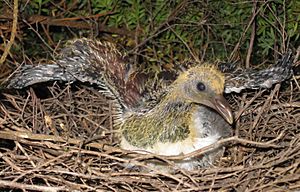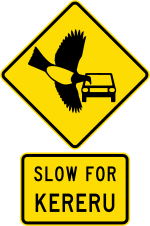Kererū facts for kids
Quick facts for kids Kererū |
|
|---|---|
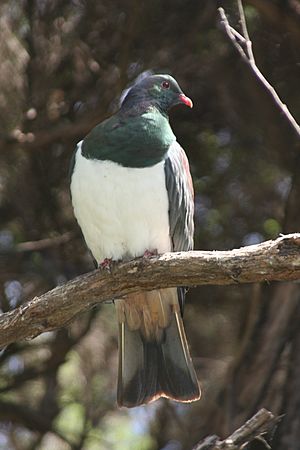 |
|
| On Kapiti Island, New Zealand | |
| Conservation status | |
| Scientific classification | |
| Genus: |
Hemiphaga
|
| Species: |
novaeseelandiae
|
The kererū (Hemiphaga novaeseelandiae), also known as the New Zealand pigeon, is a large, colourful bird. It is the only pigeon that lives only on the New Zealand mainland. You can easily spot a kererū because of its size and the loud "whoosh" sound its wings make when it flies.
Kererū are very important for New Zealand's forests. They are the only birds that can swallow large native fruits whole. This helps spread the seeds of many native trees, allowing new trees to grow. For Māori, the kererū was a valuable food source. It was one of the main foods gathered during the New Year.
Even though kererū live in forests and cities, their numbers have dropped a lot. This happened after Europeans arrived and brought animals like rats and possums. Hunting kererū is now against the law.
Contents
What's in a Name?
The most common name for this bird is "Kererū". This comes from the Māori people. In some parts of the North Island, especially Northland, it's also called kūkupa or kūkū.
Sometimes, people call them "wood pigeons". However, they are different from the common wood pigeon found in other parts of the world.
What Does a Kererū Look Like?
The kererū is a big bird, weighing about 550 to 850 grams. It lives in forests all over New Zealand, from Northland to Stewart Island/Rakiura. You can find them near the coast or high up in the mountains.
Kererū have a small head, a soft beak, and feathers that look a bit loose. Their head, throat, and wings are a shiny green-purple colour. These feathers can look bronze in different lights. Their chest is usually white, and their beak is red with an orange tip. Their feet and eyes are also red. Young kererū look similar but have paler colours and a shorter tail.
Kererū make soft "coo" sounds. Their wings make a very clear "whooshing" sound when they fly. Their flight is also special. They often fly up slowly, then dive down in a steep curve. This behaviour might be linked to nesting.
Kererū Family Tree
There used to be two types (subspecies) of New Zealand pigeon. One was the mainland New Zealand pigeon (H. n. novaseelandiae). The other was the Norfolk pigeon (H. n. spadicea) from Norfolk Island, which is now extinct. These two types had slightly different colours and shapes.
In 2001, scientists suggested that the Chatham Island pigeon (H. n. chathamensis) was different enough to be its own species, H. chathamensis. Most experts now agree with this. The Chatham Island pigeon population has grown from only 40 birds in the 1980s to over 600 today. It is now considered "Vulnerable" by the IUCN.
The kererū belongs to the pigeon and dove family, called Columbidae. This family is found in places like Southeast Asia, Australia, and New Zealand. Most birds in this family eat fruits.
Behaviour
What Kererū Eat (Diet)
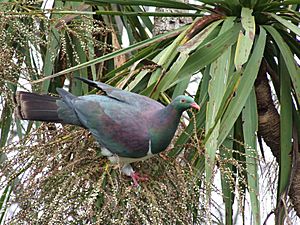
Kererū mainly eat fruit from native trees. They also eat leaves, flowers, and buds. They are super important for the environment because they are the only birds that can eat the largest native fruits. By eating these fruits, they help spread the seeds of trees like the taraire.
Their diet changes with the seasons. When there's less fruit, they eat more leaves and buds. Some of their favourite leaves include kowhai, tree lucerne, willow, and elm.
Reproduction and Life Cycle
Kererū usually breed when there is plenty of ripe fruit available. This can change depending on the season and where they live. In the warmer northern parts of the North Island, they can nest all year round if there's enough fruit. Further south, breeding usually happens between October (spring) and April (autumn).
Kererū build simple nests in trees using a few twigs. The female lays just one egg. The egg hatches after about 28 to 29 days. The young bird stays in the nest for another 30 to 45 days before it can fly. If there's lots of fruit, a pair of kererū can nest successfully up to four times in one season!
Where Kererū Live and How We Protect Them
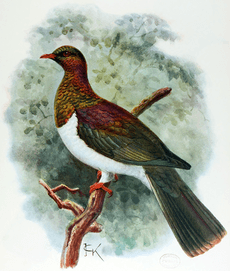
The number of New Zealand pigeons has gone down a lot since people first arrived in New Zealand. This is still happening, especially in the North Island. However, they are still quite common in the west of the South Island and near the coast in Otago. You can often find them in native forests, bushes, the countryside, and even in city gardens and parks.
Animals brought to New Zealand, like the Australian common brushtail possum and different types of rats (like the ship rat and brown rat), have caused problems. They eat a lot of the fruit that kererū need. They also eat kererū eggs and young chicks in their nests.
Kererū populations are also threatened by illegal hunting and changes to their homes (habitat). In the past, kererū were very common. There were so many that large groups would gather in trees to eat fruit. Laws to protect them started as early as 1864, and they have been fully protected since 1921. This means it's illegal to hunt them.
Kererū in Māori Culture
Kererū are considered very special (taonga) to Māori. Traditionally, Māori used the birds for their meat and their beautiful feathers. For some iwi (tribes), like Ngāi Tūhoe, the kererū is an important part of their culture.
Māori often caught kererū using snares. Sometimes, they used special water troughs in trees with snares around them. When the kererū came to drink, they would get caught. Sometimes, tame kererū were used to attract other birds. Once caught, the birds were often kept in their own fat in special gourd containers called tahā huahua. Their feathers were used to make korowai (cloaks), and their tails decorated the tahā huahua.
The kererū also appears in Māori stories and myths. It is linked to the hero and trickster Māui. One story says that Māui turned into a kererū when he went to the underworld to find his parents. The kererū's green-blue and white colours come from this story. When Māui changed into the bird, he was carrying his mother's apron and belt. The white chest feathers are like his mother's apron, and the green-blue feathers on the neck are like her belt.
Since the 1990s, there has been talk about whether Māori should be allowed to traditionally harvest kererū again. However, the kererū is a protected species under the Wildlife Act 1953. This means it is illegal to hunt them. Currently, Māori can only use feathers and bones from kererū that have died naturally and are collected by the Department of Conservation.
Images for kids
See also
 In Spanish: Paloma maorí para niños
In Spanish: Paloma maorí para niños




